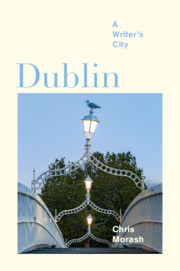Book contents
- Dublin
- Imagining Cities
- Dublin
- Copyright page
- Dedication
- Contents
- A Writer’s City: Series Preface
- Chronology
- Additional material
- Introduction The Imagined City in Time of Pandemic
- 1 Mapping the City
- 2 Baggotonia
- 3 Around St. Stephen’s Green
- 4 Trinity College
- 5 Around the Liberties
- 6 O’Connell Street and the Abbey Theatre
- 7 The North Inner City
- 8 South Dublin
- 9 The South Coast
- 10 North Dublin
- 11 Riverrun
- Read On …
- Notes
- Bibliography
- Acknowledgements
- Index
- Plate Section
11 - Riverrun
Published online by Cambridge University Press: 16 February 2023
- Dublin
- Imagining Cities
- Dublin
- Copyright page
- Dedication
- Contents
- A Writer’s City: Series Preface
- Chronology
- Additional material
- Introduction The Imagined City in Time of Pandemic
- 1 Mapping the City
- 2 Baggotonia
- 3 Around St. Stephen’s Green
- 4 Trinity College
- 5 Around the Liberties
- 6 O’Connell Street and the Abbey Theatre
- 7 The North Inner City
- 8 South Dublin
- 9 The South Coast
- 10 North Dublin
- 11 Riverrun
- Read On …
- Notes
- Bibliography
- Acknowledgements
- Index
- Plate Section
Summary
If James Joyce’s final novel, Finnegans Wake, can be said to be set anywhere, it is in a pub in Chapelizod, in the west of Dublin along the River Liffey, beside the Phoenix Park, which marks the city’s historical western boundary. This had already been the location for gothic fiction by Sheridan Le Fanu in the nineteenth century, and the poet Thomas Kinsella would often return in his writing to the area around the Park, and nearby Inchicore, where he grew up. However, before any of these writers, the Phoenix Park itself developed a literature of its own in the eighteenth and nineteenth centuries, and was a place for promenading and for duelling. Today, the contrast between past and present is sharper in this part of the city than perhaps anywhere else. With the rapid geographical spread of Dublin since the middle of the twentieth century, new suburbs have spread far beyond the original western bounds of the city, extending into neighbouring counties. It is here that the challenge of finding literary forms adequate to the life of its citizens is felt most strongly in a city that has long defined itself as a writer’s city.
- Type
- Chapter
- Information
- DublinA Writer's City, pp. 230 - 251Publisher: Cambridge University PressPrint publication year: 2023



